.
Now the sanctuary of Athena Chalinitis is by their theater, and near is a naked wooden image of Heracles, said to be a work of Daedalus. All the works of this artist, although rather uncouth to look at, are nevertheless distinguished by a kind of inspiration ...being condemned by Minos on some charge he was thrown into prison along with his son. He escaped from Crete and came to Cocalus at Inycus, a city of Sicily. Thereby he became the cause of war between Sicilians and Cretans, because when Minos demanded him back, Cocalus refused to give him up. He was so much admired by the daughters of Cocalus for his artistic skill that to please him these women actually plotted against Minos to put him to death. It is plain that the renown of Daedalus spread over all Sicily and even over the greater part of Italy...Pausanias.
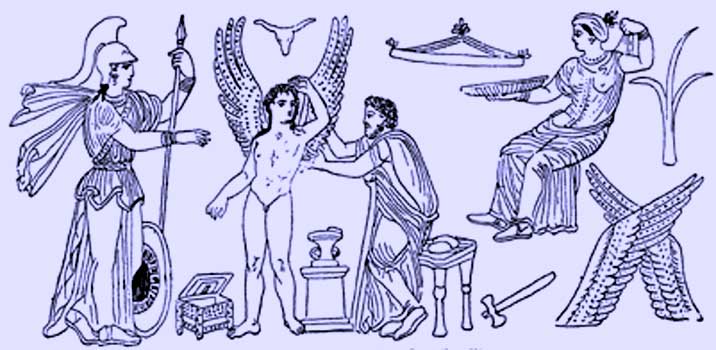
Daedalus fixing the wings for Icarus, Vase Painting
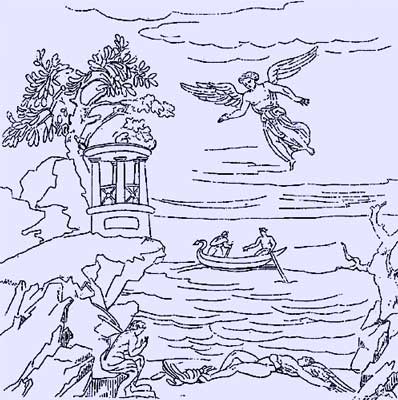
Drawing based on a painting from Herculaneum

Daedalus and Icarus, Villa Imperiale
In Greek mythology, Daedalus (also Daedalos and Daidalos, Δαίδαλος) was a most skillful artificer and was even said to have first invented images. He built for Ariadne a wide dancing-ground (Iliad xviii.591), and Homer also still calls her by her Cretan name, the "Lady of the Labyrinth" (Iliad xviii.96) which Daedalus also made, in which the Minotaur was kept and from which Theseus escaped by means of the thread clue of Ariadne. The labyrinth was an edifice with numberless winding passages and turnings opening into one another, seeming to have neither beginning nor end. Daedalus built it for King Minos, but afterwards lost the favor of the king, and was shut up in a tower.
Minos had to have the labyrinth to imprison his wife's son: the Minotaur. Daedalus had built Minos' wife, Pasiphae, a wooden cow so she could mate with the bull. Poseidon had cursed her with zoophilia.
Daedalus could not leave the island by sea, as the king kept strict watch on all the vessels, and permitted none to sail without being carefully searched. Since Minos controlled the land and sea routes, Daedalus set to work to fabricate wings for himself and his young son Icarus. He tied feathers together beginning with the smallest and adding larger, so as to form an increasing surface. The larger ones he secured with thread and the smaller with wax, and gave the whole a gentle curvature like the wings of a bird. When at last the work was done, the artist, waving his wings, found himself buoyed upward and hung suspended, poising himself on the beaten air. He next equipped his son in the same manner, and taught him how to fly. When both were prepared for flight, Daedalus warned Icarus not to fly too high, because the heat of the sun would melt the wax, nor too low because the sea foam would make the wings wet and they would no longer fly. Then the father and son flew away.
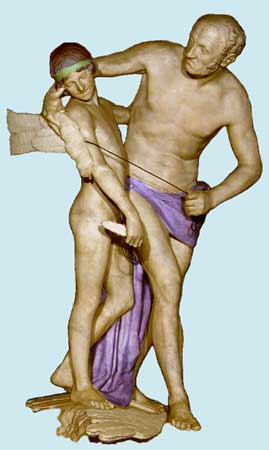
They had passed Samos, Delos and Lebynthos when the boy began to soar upward as if to reach heaven. The blazing sun softened the wax which held the feathers together, and they came off. Icarus fell into the sea. His father cried and bitterly lamenting his own arts, called the land near the place where Icarus fell into the ocean Icaria in memory of his child. Daedalus arrived safe in Sicily in the care of King Cocalus, where he built a temple to Apollo, and hung up his wings, an offering to the god.
Minos, meanwhile, searched for Daedalus by travelling from city to city asking a riddle. He presented a spiral seashell and asked for it to be strung all the way through. When he reached Camicus, King Cocalus, knowing Daedalus would be able to solve the riddle, fetched the old man. He tied the string to an ant, which walked through the seashell, stringing it all the way through. Minos then knew Daedalus was in the court of King Cocalus and demanded he be handed over. Cocalus managed to convince him to take a bath first. Cocalus' daughters then killed Minos.
Daedalus was so proud of his achievements that he could not bear the idea of a rival. His sister had placed her son Perdix under his charge to be taught the mechanical arts. He was an apt scholar and gave striking evidences of ingenuity. Walking on the seashore he picked up the spine of a fish. Imitating it, he took a piece of iron and notched it on the edge, and thus invented the saw. He put two pieces of iron together, connecting them at one end with a rivet, and sharpening the other ends, and made a pair of compasses. Daedalus was so envious of his nephew's performances that he took an opportunity, when they were together one day on the top of a high tower, to push him off. But Athena, who favors ingenuity, saw him falling, and arrested his fate by changing him into a bird called after his name, the partridge. This bird does not build his nest in the trees, nor take lofty flights, but nestles in the hedges, and mindful of his fall, avoids high places. For this crime, Daedalus was tried and banished.
Daedalus had two sons: Icarus and Iapyx.
Daedalus gave his name eponymously to any Greek artificer and to many Greek contraptions that represented dextrous skill. At Plataea there was a festival, the Daedala, in which a temporary wooden altar was fashioned, an effigy was made from an oak-tree and dressed in bridal attire, and carried in a cart with a woman who acted as bridesmaid. The image was called Daedale and the archaic ritual given an explanation through a myth to the purpose.
Apollodorus. Bibliotheke. III.i.4, III.xv.8; Apollodorus. Epitome. I.8-15; Ovid. Metamorphoses. VIII.180-262; Ovid. Ars Amatoria. II
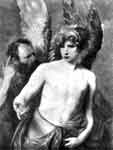
"Be careful Icarus!", Daedalus and Icarus, Sir Anthony Van Dyck
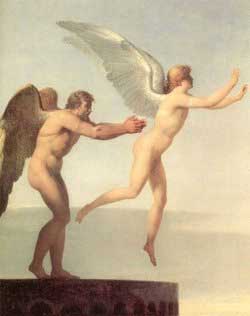
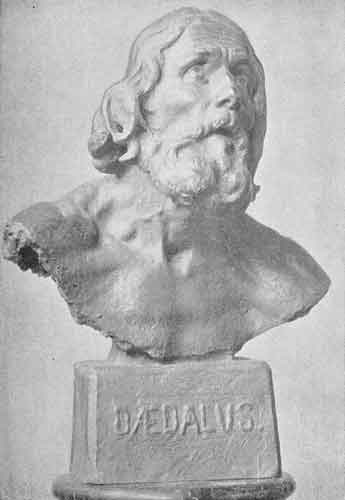
Daedalus, Charles Grafly (3.12.1862 - 5.5. 1929), American sculptor , from a 1893 publication
Daedalus, or Mechanical Skill Explained of Arts and Artists in Kingdoms and States, Francis Bacon 1609
The Story of Pasiphae, Theseus and the Minotaur
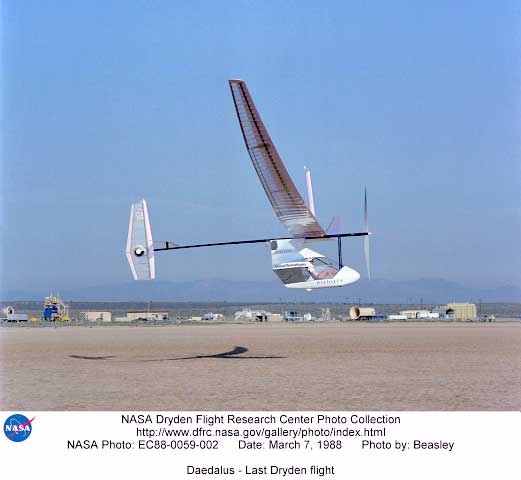
The MIT Daedalus flying vehicle with K. Kanellopoulos
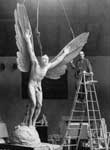
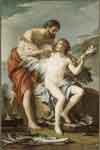
Daedalus and Icarus, Joseph Marie Vien
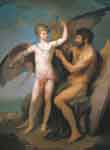
Daedalus Attaching Wings to Icarus, Pyotr Ivanovich Sokolov
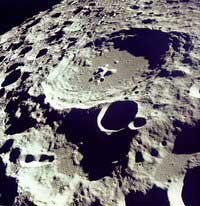
N. Rudd, Daedalus and Icarus: (i) From Rome to the End of the Middle Ages. (ii) From the Renaissance to the Present Day. Appendix: Daedalus and Icarus in Art. In: Ch. Martindale (Ed.), Ovid Renewed. Ovidian influences on Literature and Art from the Middle Ages to the Twentieth Century, Cambridge 1988
See also Icarus for more paintings
Music:
See also : Greek Mythology. Paintings, Drawings
| Ancient Greece
Science, Technology , Medicine , Warfare, , Biographies , Life , Cities/Places/Maps , Arts , Literature , Philosophy ,Olympics, Mythology , History , Images Medieval Greece / Byzantine Empire Science, Technology, Arts, , Warfare , Literature, Biographies, Icons, History Modern Greece Cities, Islands, Regions, Fauna/Flora ,Biographies , History , Warfare, Science/Technology, Literature, Music , Arts , Film/Actors , Sport , Fashion --- |
Retrieved from "http://en.wikipedia.org"
All text is available under the terms of the GNU Free Documentation License

